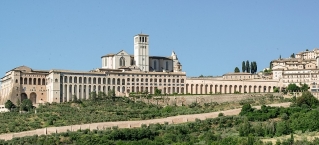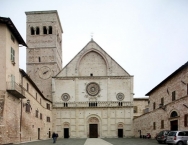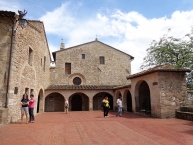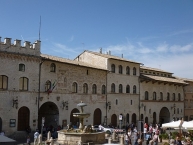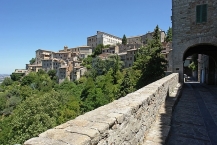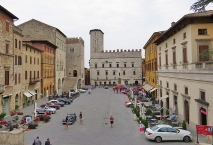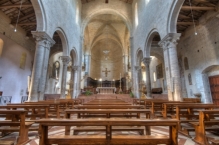Radtour Italien Coast2Coast
Geplante Tour: From Ancona to Orbetello
Aktionen
![]()
Bitte warten - Kartendaten werden geladen
Erstellt am 02.02.2020,
zuletzt geändert von agocurti am 02.02.2020
Aktionen
Strecken-Merkmale
geplant
gefahren
Gesamtlänge in km
450
0
Gesamthöhenmeter Aufstieg
12.300
0
Durchschn. Steigung Aufstieg %
2,73
-
Gesamthöhenmeter Abstieg
12.300
0
Informationen zu Rechten an den GPS-Track-Daten | |
|---|---|
Rechte-Inhaber | |
Rechte-Ausprägung / Lizenz | cc0: Public Domain keine Rechte vorbehalten |
Link zur Rechtebeschreibung | |
gpx-Datei hochgeladen | durch agocurti am 02.02.2020
|
Gesamtzahl Trackpoints
9.322
0
Trackpoint-Dichte per km
21
0
Endorte
Start
Ancona, MAR, IT (-24 m NHN)
Ziel
Orbetello, Tuscany, IT (3 m NHN)
Fahrradfreundliche Unterkünfte, Sehenswertes und Infrastruktur
Name u. Anschrift
Breite / Länge
Tel.
Fax.
Mobile
Art d. Unterkunft
Radler-freund-lichkeit
Strecken-km
km zur Strecke
Höhe
180 km
0,3 km
421 m
Informationen zu Urheber-Rechten | |
|---|---|
Rechte-Inhaber | |
Rechte-Ausprägung / Lizenz | by-sa: CREATIVE COMMONS Namensnennung, Weitergabe unter gleichen Bedingungen |
Link zur Rechtebeschreibung | |
Bild übernommen aus | https://commons.wikimedia.org/wiki/File:Basilica_di_San_Francesco,_May_2017.jpg |
Bild hochgeladen | durch biroto-Redaktion am 13.10.2022
|
Informationen zu Urheber-Rechten | |
|---|---|
Rechte-Inhaber | |
Rechte-Ausprägung / Lizenz | by-sa: CREATIVE COMMONS Namensnennung, Weitergabe unter gleichen Bedingungen |
Link zur Rechtebeschreibung | |
Bild übernommen aus | https://commons.wikimedia.org/wiki/File:Facade_and_tower_-_San_Rufino_-_Assisi_2016.jpg |
Bild hochgeladen | durch biroto-Redaktion am 13.10.2022
|
Informationen zu Urheber-Rechten | |
|---|---|
Rechte-Inhaber | |
Rechte-Ausprägung / Lizenz | by-sa: CREATIVE COMMONS Namensnennung, Weitergabe unter gleichen Bedingungen |
Link zur Rechtebeschreibung | |
Bild übernommen aus | https://commons.wikimedia.org/wiki/File:San_Damiano_(Assisi)_01.JPG |
Bild hochgeladen | durch biroto-Redaktion am 13.10.2022
|
Informationen zu Urheber-Rechten | |
|---|---|
Rechte-Inhaber | https://commons.wikimedia.org/w/index.php?title=User:Diego_Baglieri |
Rechte-Ausprägung / Lizenz | by-sa: CREATIVE COMMONS Namensnennung, Weitergabe unter gleichen Bedingungen |
Link zur Rechtebeschreibung | |
Bild übernommen aus | https://commons.wikimedia.org/wiki/File:Residenza_municipale_-_Assisi_05.jpg |
Bild hochgeladen | durch biroto-Redaktion am 13.10.2022
|
Assisi is a small medieval town of about 25,000 people perched on a hill in Umbria, the heart of Italy. Famous as the birthplace of St. Francis, Assisi holds religious, historical, and artistic significance. Periodical exhibits and fairs enrich the visitor's experience.
See
Definitely take the time to walk among Assisi's medieval houses and shops. Most of the cobblestone streets and alleys will take you to the basilica of St. Francis.
The basilica of St. Francis is only one of many beautiful churches in Assisi. The cathedral of San Rufino, the basilica of Santa Chiara, and the Chiesa Nuova are also worth a visit. Take the time to hike up to the top of the hill above Assisi and explore the castle - ⊙"La Rocca" - where Frederick Barbarossa spent his childhood. From here you can overlook the town and the valley below. Visit the tiny church of St. Stefano, go up a few stairs, and look back downwards for the most picturesque spot of this beautiful little town.
- ⊙Basilica of San Francesco d'Assisi
 . Basilica was completed in 1253. The walls and ceilings of the upper church are embellished with frescoes of the Giotto school; the lower sanctuary contains the tomb of St. Francis. It's a good idea to rent the audio guide to appreciate the artistic and historical significance of this unique church. Please be quiet as you visit this multi-level structure as it still is a place of prayer for many.
. Basilica was completed in 1253. The walls and ceilings of the upper church are embellished with frescoes of the Giotto school; the lower sanctuary contains the tomb of St. Francis. It's a good idea to rent the audio guide to appreciate the artistic and historical significance of this unique church. Please be quiet as you visit this multi-level structure as it still is a place of prayer for many. - ⊙Treasury Museum of the Basilica of San Francesco (Museo del Tesoro della Basilica di San Francesco), Piazza San Francesco 1. 10.00-13.00; 14.00-17.30. Free admission. (updated May 2019)
- ⊙San Rufino Cathedral. It has probably the most beautiful façade of all the churches in town. If you have some time to spare visit the museum.
- ⊙Assisi Diocesan Museum (Museo diocesano e cripta di San Rufino), Palazzo dei Canonici, Piazza San Rufino 3 (attached to San Rufino Cathedral). March-October 10:00-13:00 – 15:00-18:00. (updated May 2019)
- Following Via San Rufino (walking down in front of the Cathedral) you arrive to ⊙Piazza del Comune, the center of the town. There is a small fountain known as the "lions fountain". There are two main attractions on the Piazza: the "Palazzo del Capitano del Popolo" with the clock tower and the beautiful church of Santa Maria Sopra Minerva (St. Mary over Minerva), with its impressive roman columns. Assisi, being an old roman town, had its own temple dedicated to Minerva, the goddess of wisdom. With the arrival of Christianity the temple was transformed into a Catholic church and the Virgin Mary was promoted above pagan wisdom. The church was completely remodeled in the early 1990s and stands in stark contrast to the exterior. In Piazza del Comune you find also the Tourist Information Center.
- From the "Lions Fountain" find the street called "Corso Mazzini". Here you will find many interesting shops of all sorts. At the end of the street you'll find and archway and after that you will see the lovely St. Claire's Basilica, where the original crucifix, that spoke to Saint Francis, is found. There is a lovely piazza in front of the Church, with wonderful views of the valley. Morning and Evening prayer is beautiful here, with the choir of cloistered Poor Clare nuns singing.
- Re-tracing your steps you can go back to Piazza del Comune, passing on your left a little street that takes you to "Chiesa Nuova", a very spiritual little church built over to what is said to be Francis' original home.
- From Piazza del Comune you have two options to reach Saint Francis' Basilica:
- a) the street to your right is "Via San Paolo", and it will eventually lead you to the Basilica. This is a slightly longer way to get there and not so crowded, sometimes there is no one around, even on busy days! After you walk a little on Via San Paolo turn to your left when you see some steps and a fresco on the wall, follow the steps down until you get to the small church of St. Stephen (Santo Stefano). This is a real jewel, not known to many and skipped by the majority of "running pilgrims". Even if for 5 minutes it is a must-see.
- b) the street to your left from Piazza del Comune is called "Via Portica". This is the usual and shorter way to go to the Basilica of Saint Francis. There are plenty of shops. On your left you will eventually find the Metastasio theater, with an continual exhibit about St. Clare. After a short while you pass an archway and arrive to "Via San Francesco". A little walk and to your left you will see a little chapel called the "Oratorio dei Pellegrini" (the Pilgrim's Chapel). It only opens for a few hours during the day when it is open there is almost always Eucharistic adoration. Inside this room you will find some of the most beautiful frescos of the town. In this same street to your right you can find some very interesting museums.
- At the end of the street you will find the ⊙Basilica of St. Francis, with everything to discover. Start at the upper Basilica. Make sure you make it to the lower church and down the stairs to the Tomb of Saint Francis. This is one of the most spiritually powerful places in Assisi.
- When you finish your visit of the Basilica you will exit on the lower part, in front of Piazza San Francesco. Walk down the Piazza, cross the archway and walk down Via Frante Elia. When you arrive to the bottom of the street to your left you will see a big Church, ⊙San Pietro. This is another "must see" of the city that is many times ignored. Differently to other churches in town, the interior is more beautiful than the exterior.
If you have more time, these are some hints:
- ⊙San Damiano
 . The little church of San Damiano is outside the walls of the city, halfway down the hill, but easily accessible from Porta Nuova, near St. Clare's Basilica. According to the saint's biographers, it was here that St. Francis received his message "to rebuild the church." This is one of the most "franciscan" places in town and it is definitely worth the small detour from the centre. If you are staying in for some days they have a lovely 07:30 morning mass, with beautiful music.
. The little church of San Damiano is outside the walls of the city, halfway down the hill, but easily accessible from Porta Nuova, near St. Clare's Basilica. According to the saint's biographers, it was here that St. Francis received his message "to rebuild the church." This is one of the most "franciscan" places in town and it is definitely worth the small detour from the centre. If you are staying in for some days they have a lovely 07:30 morning mass, with beautiful music. (updated May 2019)
- ⊙Santa Maria Maggiore Church, near "Piazza del Vescovado". In a little hidden angle of the town, a beautiful well kept Church (don't be cheated by its unassuming façade). Going down the hill a little look for the monastery of St Quirico - early in the morning and at 6 pm the Poor Clare nuns have morning and evening prayer - differently to the Poor Clares in Sta Chiara (who are hidden from view), you can actually see the sisters during prayers and at the end even exchange a couple of words.
- ⊙Oratorio San Francesco Piccolino. From Corso Mazzini you follow some little steps and arrive to a very little chapel where the legend says Francis was actually born.
- ⊙Rocca Maggiore.A lovely site with wonderful views. A good climb so be prepared for a walk. The structure has been restored and besides the wonderful architecture and the views you can also see an exhibition based on the Calendimaggio, the spring festival of the city.
- On the "back" of Piazza del Comune you can find a lovely and basically unknown area of the town, with beautiful houses, lovely views, some shrines for Our Lady and one or two cats having a nap. Look for the unconsecrated ⊙Church of Sta Maria delle Rose.
- ⊙Chiesa di Santa Margherita (Church of Saint Margaret). Among the little streets in front of St Francis Basilica. You have lovely views of the Basilica from the small Piazza.
- ⊙Indios Missionary Museum (MUMA).
- ⊙Gallery of Contemporary Art of the Pro Civitate Christiana (Galleria d’Arte Contemporanea della Pro Civitate Christiana), Via degli Ancajani 3.
Informationen zu Urheber-Rechten | |
|---|---|
Rechte-Ausprägung / Lizenz | by-sa: CREATIVE COMMONS Namensnennung, Weitergabe unter gleichen Bedingungen |
Link zur Rechtebeschreibung | |
Text(e) übernommen von: |
Wikivoyage contributors, 'Assisi', Wikivoyage, The FREE worldwide travel guide that anyone can edit, 2 March 2022, 00:22 UTC, https://en.wikivoyage.org/w/index.php?title=Assisi&oldid=4398917 |
übernommen / bearbeitet am | 12.10.2022 - 13.10.2022
|
übernommen / bearbeitet durch |
|
180 km
0,3 km
420 m
Informazioni E Accoglienza Turistica Di Assisi
IT-06081 Assisi
Touristen Information
Öffnungszeiten
Mo-So 09:00-19:00
185 km
3,0 km
198 m
235 km
0,5 km
403 m
Informationen zu Urheber-Rechten | |
|---|---|
Rechte-Inhaber | |
Rechte-Ausprägung / Lizenz | cc0: Public Domain keine Rechte vorbehalten |
Link zur Rechtebeschreibung | |
Bild übernommen aus | https://commons.wikimedia.org/wiki/File:Todi_stadtansicht.jpg |
Bild hochgeladen | durch biroto-Redaktion am 12.10.2022
|
Informationen zu Urheber-Rechten | |
|---|---|
Rechte-Inhaber | |
Rechte-Ausprägung / Lizenz | by-sa: CREATIVE COMMONS Namensnennung, Weitergabe unter gleichen Bedingungen |
Link zur Rechtebeschreibung | |
Bild übernommen aus | |
Bild hochgeladen | durch biroto-Redaktion am 12.10.2022
|
Informationen zu Urheber-Rechten | |
|---|---|
Rechte-Inhaber | Paolo Avezzano |
Rechte-Ausprägung / Lizenz | by-sa: CREATIVE COMMONS Namensnennung, Weitergabe unter gleichen Bedingungen |
Link zur Rechtebeschreibung | |
Bild übernommen aus | https://commons.wikimedia.org/wiki/File:Interno-Cattedrale-Todi.jpg |
Bild hochgeladen | durch biroto-Redaktion am 12.10.2022
|
Todi is a small hilltown (pop. ~17,000) in Umbria . It overlooks the east bank of the river Tiber, and is both impressive from a distance and has impressive views from its centre. Both the town centre and the outskirts have fascinating buildings. As a town it began to boom after becoming a free commune in the 1200s and many of its interesting buildings date from that time.
See
- ⊙Piazza del Popolo (People’s Square). contains most of the major sights. It was built on top of Roman cisterns, many of which remained in use until the 1920s.
- ⊙Cathedral. It is an impressive Gothic building said to be erected over an ancient Roman temple. The current church was rebuilt after a fire in 1190. The main feature of the façade is the great rose-window, which was added in the 16th century. The church follows the plan of the Latin cross, with a nave and two aisles. There is a giant fresco depicting the Universal Judgment by Ferraù Faenzone. The choir includes the Gothic altar and a wooden choir-enclosure with two floors.
- ⊙Palazzo del Popolo (Communal Palace). It was already existing in 1213 and is one of the most ancient communal palaces in Italy. It houses the city's Art Gallery.
- ⊙Palazzo del Capitano. It was built around 1293 and named "New Communal Palace" to differentiate it from the first one.
- ⊙Palazzo dei Priori. On the southern side of the Piazza, facing the Cathedral. It was begun in 1293.
- ⊙Palazzo Vescovile. To the left of the Cathedral, this Bishop's Palace was built in 1593.
Away from Piazza del Popolo are to be found:
- ⊙Church of San Fortunato. It was begun in 1292 but work was interrupted by the plague of 1348 and the façade has never been completed. It has some interesting artwork. Piazza del Popolo is constructed on one of the two crests of Todi’s hill: San Fortunato on the other. (updated Jan 2016)
- ⊙Santa Maria della Consolazione. It is considered to be the most impressive of Todi’s churches. It is to be found just outside the city walls. The altar houses an image of the Madonna, which, according to the tradition, was discovered by a worker during the early construction.
- From the nearby ⊙Monastero delle Lucrezie you have a nice view of the town.
Informationen zu Urheber-Rechten | |
|---|---|
Rechte-Ausprägung / Lizenz | by-sa: CREATIVE COMMONS Namensnennung, Weitergabe unter gleichen Bedingungen |
Link zur Rechtebeschreibung | |
Text(e) übernommen von: |
Wikivoyage contributors, 'Todi', Wikivoyage, The FREE worldwide travel guide that anyone can edit, 22 February 2021, 16:49 UTC, https://en.wikivoyage.org/w/index.php?title=Todi&oldid=4153464 |
übernommen / bearbeitet am | 12.10.2022
|
übernommen / bearbeitet durch |
|
283 km
0,1 km
134 m
![]()

